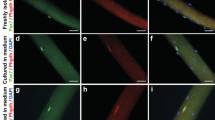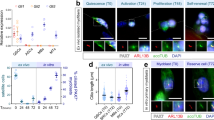Abstract.
Muscle satellite cells are believed to form a stable, self-renewing pool of stem cells in adult muscle where they function in tissue growth and repair. A regulatory disruption of growth and differentiation of these cells is assumed to result in tumor formation. Here we provide for the first time evidence that sonic hedgehog (Shh) regulates the cell fate of adult muscle satellite cells in mammals. Shh promotes cell division of satellite cells (and of the related model C2C12 cells) and prevents their differentiation into multinucleated myotubes. In addition, Shh inhibits caspase-3 activation and apoptosis induced by serum deprivation. These effects of Shh are reversed by simultaneous administration of cyclopamine, a specific inhibitor of the Shh pathway. Taken together, Shh acts as a proliferation and survival factor of satellite cells in the adult muscle. Our results support the hypothesis of the rhabdomyosarcoma origin from satellite cells and suggest a role for Shh in this process.
Similar content being viewed by others
Author information
Authors and Affiliations
Corresponding author
Additional information
Received 23 February 2005; received after revision 2 May 2005; accepted 9 June 2005
Rights and permissions
About this article
Cite this article
Koleva, M., Kappler, R., Vogler, M. et al. Pleiotropic effects of sonic hedgehog on muscle satellite cells. CMLS, Cell. Mol. Life Sci. 62, 1863–1870 (2005). https://doi.org/10.1007/s00018-005-5072-9
Published:
Issue Date:
DOI: https://doi.org/10.1007/s00018-005-5072-9




